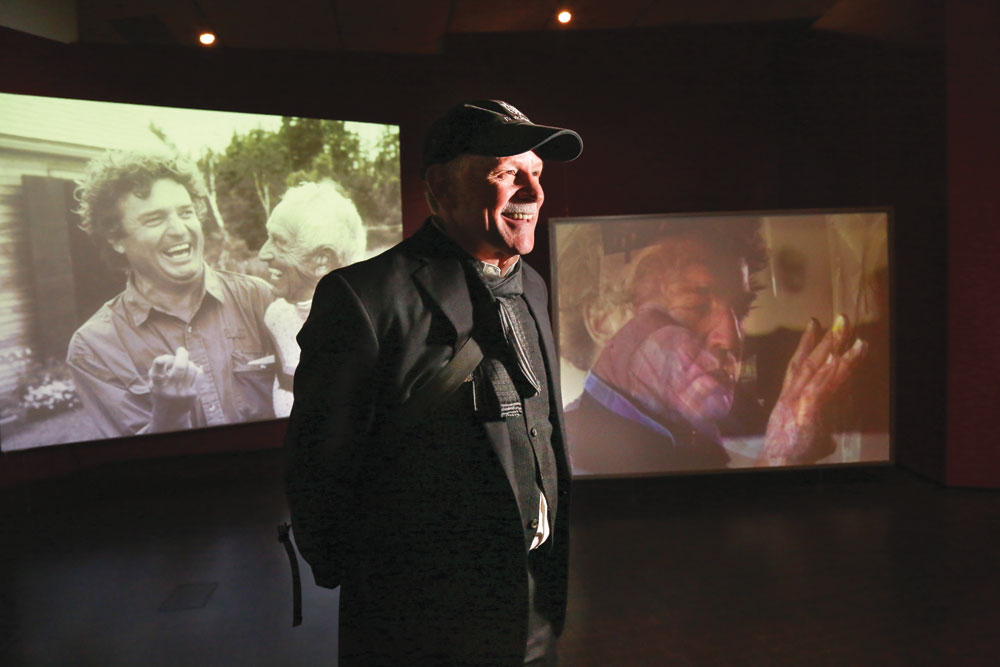
Timothy Standring, curator of Wyeth at the Denver Art Museum: “I hope this show changes the discourse about the Wyeths, to look at their true artistic intentions. The Wyeths were in love with painting; they’re freezing emotions on paper. But they’re not the clichés of beauty that we think about.”
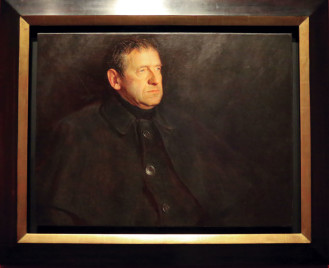
Portrait of Andrew Wyeth by Jamie Wyeth, 1969. Father and son painted each other’s portraits. “It was a subtle, quiet dialogue between the two,” Curator Standring said.
“Andrew and Jamie Wyeth are two artists who respond poetically to the world around them,” said Timothy Standring, curator of Wyeth: Andrew and Jamie in the Studio, the first-ever pairing of works by the famous father-and-son artists. “Poems help us stop and say, ‘Yes, that fleeting moment was worthwhile.’ Both Wyeths sought to capture fleeting moments in visual form. And because they worked in the vernacular of realism, they were able to do that.”
Wyeth, on view at the Denver Art Museum through Feb. 7, features more than 100 works in a variety of media, including pen and ink, graphite, charcoal, watercolor, tempura, oil and mixed media.
The Wyeths are a dynasty of American artists, including Andrew’s father, N.C. Wyeth, one of America’s great illustrators. “Andrew and Jamie’s careers overlapped for 10 decades and Jamie is still producing,” Standring said. “Their works have been shown many times but this is the first time they are mixed together. We tell their story by contrasting and comparing. You can look closer at each artist by contrasting and comparing.”
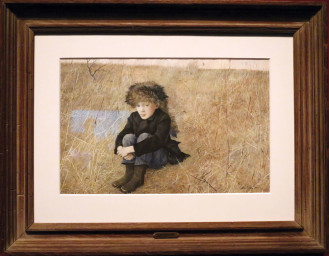
Faraway by Andrew Wyeth, 1952. Andrew said of this portrait of Jamie, “It’s a moment that I’m after, a fleeting moment but not a frozen moment.”
The exhibition is a dialogue between father and son, including side-by-side portraits: Jamie’s painting of his father and Andrew’s of his son. “It was a subtle, quiet dialogue between the two,” Standring said. “They challenged each other and responded to each other. Although their work is different, they are cut from the same cloth. Father and son are both painterly and brilliant.”
Andrew Wyeth (1917-2009), primarily a realist painter, was one of the best-known American artists of the middle 20th century. His favorite subjects were the land and people around him, both in his hometown of Chadds Ford, Pa., and his summer home in Maine. Wyeth noted: “I paint my life.”
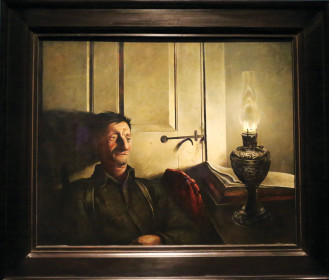
The Oil Lamp, Andrew Wyeth, 1945, portrays Alvaro Olson, a blueberry farmer, the Wyeths’ next-door neighbor in Maine. Alvaro was the brother of Christina, the subject of Wyeth’s famous Christina’s World.
“The Wyeths live in the beautiful Brandywine River Valley and they migrate to the archipelago of mid-coast Maine,” said Standring. “They respond to their place. They don’t need to travel because they convey their poetic responses to their surroundings and people.”
One of the best-known paintings in 20th-century American art is Andrew Wyeth’s 1948 Christina’s World, depicting a woman lying on the ground in a treeless field, looking up at a gray house on the horizon. Christina Olson—who had been crippled by polio in childhood—and her brother Alvaro were the Wyeth’s neighbors in Maine. Christina also posed for other portraits, including Christina Olson (1947), on display here. Although Christina’s World is not on display in this exhibit—because New York’s Museum of Modern Art never lends it—Wyeth’s Study for Christina’s World is on view. The family resemblance is apparent in his nearby portrait of Alvaro Olson, The Oil Lamp (1945).
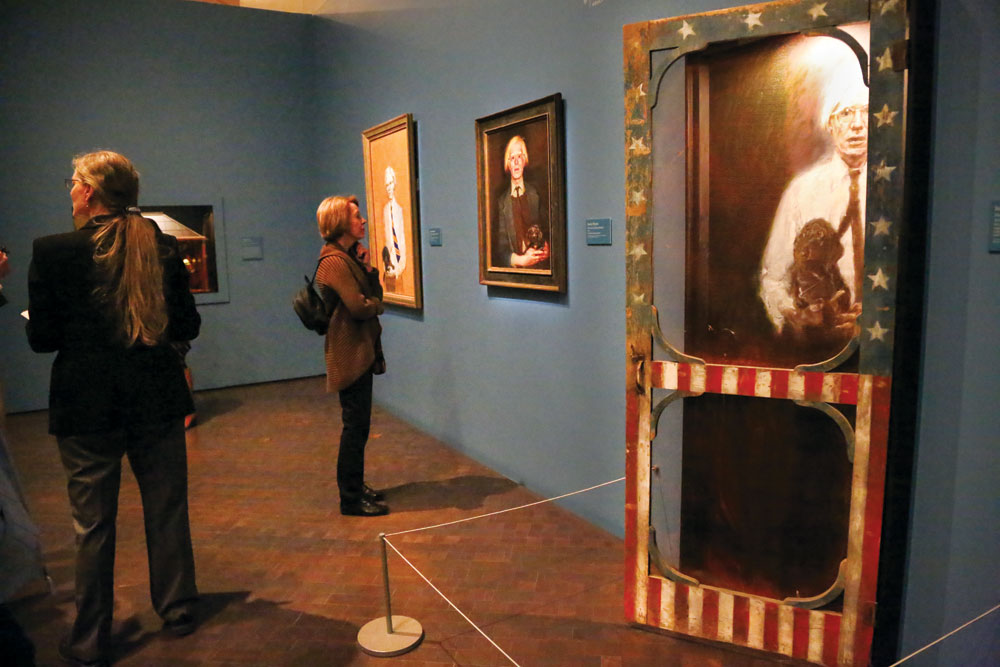
Visitors explore some of Jamie Wyeth’s work, including a portrait of Andy Warhol behind a screen door, 2015. “I met Andy through a writer friend and ended up spending some time at The Factory [Warhol’s studio],”Jamie said. “He was childlike as a person, fascinating really.”
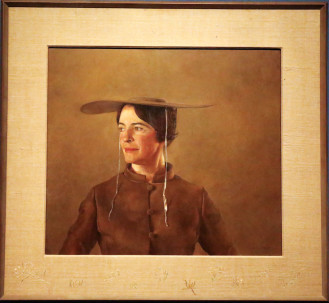
Maga’s Daughter, Andrew Wyeth, 1966. Wyeth’s wife, Betsy. “The color of those cheeks under her coal black hair and that hat gives the portrait a real edge,” said Wyeth.
Jamie Wyeth, now 69, spent much of his career as a portraitist of both people and animals. He is influenced by his father’s and grandfather’s work but he experiments with a brighter palette and includes the abstract as well as the precise.
Jamie Wyeth’s exhibited work ranges from his early portraits to his experimental and recent works, including a portrait of Andy Warhol behind a found screen door, created this year. “I met Andy through a writer friend,” Jamie said in a Denver Art Museum interview. “He was terrified of people. I thought that I would paint him behind a screen door … perhaps fitting of his fear.”
Also on view is Jamie’s Seven Deadly Sins series (2005-08), depicting seagulls in acts of human depravity. It’s both real and abstract, leaving it open to interpretation.
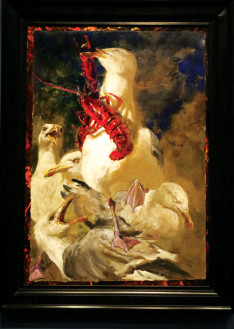
Three in The Seven Deadly Sins series, Jamie Wyeth, 2005-2008.
Pride (left), Gluttony (middle) and Anger (right). The watercolor and gouache series depicts seagulls in acts of human depravity, including envy, greed, sloth, and lust. It’s both real and abstract, leaving it open to interpretation. “Gulls are nasty birds, filled with their own jealousies and rivalries,” Jamie said.
“Jamie’s focus is on the peculiar, the incongruous,” said Standring. “Most people go to the Maine coast to paint beauty and they follow clichés of beauty. Jamie said they’re missing the drama.”
The Wyeths’ dark side is demonstrated in the last gallery, called Wondrous Strange. Works evoke the humorous as well as the macabre, including a primitive bird-like creature in a military jacket, Venetian masks and a skeleton based on Andrew’s own X-rays.
“Halloween is their national holiday,” said Standring.
Despite some unusual images, the exhibit is family friendly. Stapleton resident Shadia Lemus, communications manager for the museum, says her 6-year-old daughter will like the five “fairy doors”—tiny portals set into the walls at kids’ eye level that open to reveal surprises. “She’ll also like the paint studio. After you go through the exhibit, you can paint something on your own.”
Special admission price for Wyeth is $16 for adults and $5 for children. For more information, see denverartmuseum.org or call 720.865.5000.



0 Comments